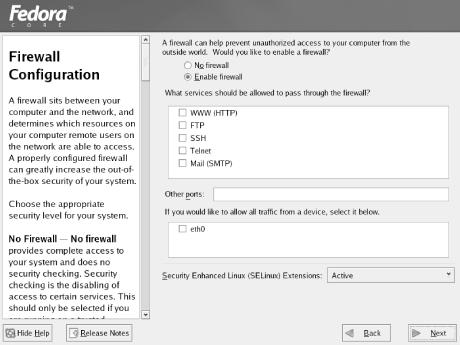Linux Distributions Supporting SELinux
Currently only Fedora Core supports SELinux by providing it as an integral component that is installed without special effort on the part of the installing user. However, Red Hat has announced that Red Hat Enterprise Linux 4 (RHEL 4) will support SELinux. The RHEL 4 implementation of SELinux is expected to closely resemble the one in Fedora Core 2.
Fedora Core 2
Fedora Core is a Linux distribution sponsored—but not supported—by Red Hat that uses the distribution as a test bed for new technologies being considered for incorporation in Red Hat’s supported distributions, such as Red Hat Enterprise Linux. Fedora Core is freely available at http://fedora.redhat.com. Unlike Red Hat Enterprise Linux, which contains proprietary components, Fedora Core is fully redistributable under the terms of the GNU GPL.
Fedora Core 2 presents the most convenient implementation of SELinux
available to date. To install SELinux, you must respond
selinux to the boot prompt that appears after
booting from the installation media.[6] During the installation procedure, the
Firewalls screen (see Figure 3-1) provides the user with the opportunity to
choose from three levels of SELinux support:
- Disabled
Disables SELinux.
- Warn
Enables SELinux to log, but not prevent, attempted violations of the SELinux policy.
- Active
Enables SELinux to fully enforce its policy.

Figure 3-1. The Fedora ...
Get SELinux now with the O’Reilly learning platform.
O’Reilly members experience books, live events, courses curated by job role, and more from O’Reilly and nearly 200 top publishers.

